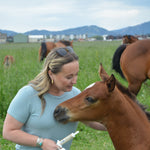Colicky Horse? Take These Steps First
September 8, 2020

Key Takeaways
- Walk the low-grade colicking horse
- Call the vet ASAP
- Assess the horse’s manure
- Withhold feed or offer small meals only
- Offer water and electrolytes
Should You Walk a Colic Horse?
To walk or not to walk? It’s a common question when it comes to colic, and sometimes it’s a topic of debate. The answer? Well, if it’s a low-grade colic—the horse is showing signs of abdominal pain or discomfort but not thrashing about—just start walking.
Drs. Rob Franklin and Keith Latson, co-founders of FullBucket, a veterinary-strength supplement business based in Weatherford, Texas, recently discussed truths and fallacies that circulate about colic in horses and steps to take until the veterinarian arrives.
“It doesn’t matter if you’re a backyard owner, if you’re a trainer, a professional, everyone is pretty well familiar with the fact that horses get colic but, beyond that, there is a whole bunch of information that’s out there. Some of it is old wives’ tales, and some of it is really sage advice from experienced horsemen,” says Franklin, who is a veterinary internal medicine specialist. “Let’s go through some of these generalities, point out where there is evidence, and provide some clarity to horse people.”
How to Treat Colic in Horses
Low-grade signs of colic range from flank watching to lying down frequently. In these cases your first job is to get the horse walking and call your veterinarian.
Get moving. “During that interim period of initially talking to a horse owner, before I get out there to see the colic horse and evaluate it, I do like people to walk the horse,” says Latson, who is also an equine surgeon. “It gives them something to do. I have them walk the horse for five or 10 minutes and then put it back in the stall. I don’t like to walk those horses for really long periods of time because in some cases I think there is potentially a danger to having that horse out with progressively worse abdominal pain and having an owner that’s not able to get that horse back to the safety of its stall.”
Assess the horse’s environment, call the vet. Note whether your horse has eaten his feed or hay or has passed any manure before calling your veterinarian. Typically, Latson recommends taking the horse’s feed away until you see a new pile of manure and have had a chance to assess it; the manure can reveal how things are moving through the horse’s system.
“If they have passed a pile of manure that has some mucus surrounding it, which is relatively common in horses that have colic, I certainly don’t want people feeding that horse,” he explains. “That mucus, which helps manure pass smoothly, looks like a stringy yellow net and is an indication to me that the manure is not passing through quickly and that the animal is likely to be dehydrated.”
Offer water. Combat dehydration by making sure the horse has plenty of access to water. “I love it if horse owners have an electrolyte powder and can put an electrolyte solution right next to the plain water and give that horse some options for getting some salts into its system,” says Latson. “That may create some thirst, as well, for plain water, and then we go from there.”
Depending on how severely dehydrated the colic horse is, he or she might need veterinarian-administered fluids of some type delivered through a nasogastric tube or intravenously.
On the other hand, if they are passing moist fecal balls and appear to be able to pass food, “I’ll say, ‘Sure, give them a small warm bran mash, and let’s see if just the action of chewing and swallowing and stimulating the intestine—in the same way that we try and stimulate digestive tract motility with short stints of walking—gets things moving through,’” says Latson. “But no sweet feed; that’s an absolute ‘no’ to me in horses with any sort of colic, whether it’s mild or beyond.”
Franklin agrees. “Small meals will sometimes stimulate a bit of gastrointestinal motility,” he says. “I don’t mind those horses going out and walking around and sort of browsing on grass. Until I’ve given him a laxative like mineral oil, via stomach tube, that serves as a marker, and that has come through the GI tract, I typically won’t give them a full meal.”
Note changes in condition. Follow your veterinarian’s instructions and keep him or her updated on your horse’s pain level and condition. It can be helpful to incrementally record your horse’s vital signs (temperature and heart and respiratory rates); the heart rate can be a good indication of your horse’s pain level, as can his or her determination to roll, bite at the sides, appear to strain to urinate, or kick.
Take-Home Message
Keeping your veterinarian in the loop in the early stages of a colic can translate to a better outcome, because you’re not waiting to bring in the veterinarian when the horse has become more dehydrated and the potential obstruction has become more severe. Walk the horse that exhibits low-grade signs of colic, offer plain water and an electrolyte solution, and remove feed or feed small forage meals depending on your horse’s manure production status.
“I think some of these recommendations also are in the best interest of avoiding wasting time and spending time doing fruitless activities that could make the situation worse,” says Franklin.
Having intense microbiome support on hand in your barn arsenal may be a good play for unforeseen circumstances.
But remember, a healthy microbiome may prevent many types of colic in horses. The best way to support the equine microbiome is through consistent supplementation of equine probiotics and prebiotics.
